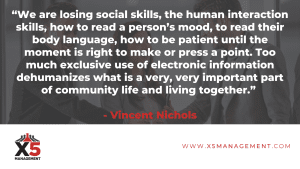One thing I enjoy most about being an entrepreneur in Edmonton is the opportunity to participate in various networking events in and around our provincial capital.
I appreciate the opportunity to be “social” with fellow members of business organizations and their guests, such as at great conferences and events.
While business may arise from meeting and connecting with great people, it is never about the sale. I saw this repeatedly during a one-day conference I attended recently.
Whether it is face-to-face interaction or leveraging your engagement on social media, events like these are essential to maintain connections and meet new people.
It’s a role I’m very comfortable with, and so were many other business people in the room. It’s interesting to watch how some individuals are exceptionally good at networking, yet others struggle with this concept.
So How Can you Become More Social in Your Networking Process?
The most tried-and-true technique I have found is taking the time to make sure the conversation is always about the other person. It’s about asking great questions to learn more about the person you’ve just met or are taking the time to reconnect with.
It should not come as a surprise that listening skills are key! It’s so crucial to listen actively to the person you’re with, and with any luck, they’ll be doing the same with you too.
Start with open dialogue and things will naturally flow the right way.
Slow it down and enjoy the moment; some people talk way too fast and probe for information like a news reporter. You’re not there to interview them, so slow it down and don’t rush the next statement or question.
When you attend a large networking event, are you the Bee or the Flower? The Bee is buzzing around the room meeting people and the Flower tends to hang in one spot and lets other people approach them.
In my experience, the split of people who are Bees versus Flowers is a pretty even 50/50. Both can be effective, but it is important to know who you are and how best to leverage that approach.
Speaking of great networking, we cover benefits of professional development this post.
What is Your Networking Style?
In my business experience, it is wonderful to see when individuals network with the “intent” of building a solid, long-term relationship. They are not handing out their business cards like a Black Jack dealer.
Networking is defined as a supportive system of sharing information and services among individuals and groups having a common interest. The reality today is that we see many people with different interests and different agendas. Sometimes these people cross paths and it just works, but in other cases, there is not any synergy or common interest.
Dr. Stephen Covey authored: “The 7 Habits of Highly Effective People.” One of my favourite habits, when applied to networking, is Habit #5:
“Seek first to understand, then to be understood.”
Covey suggests that most people seek to be understood, as they can get their point across and ignore the other person. If we take the time to truly understand the other person in terms of business needs and interests with sincere intent, we have an opportunity to establish a relationship for the long term.
Looking for new ideas on how to build relationships? Check out this link to help you stand out from yours.
Effective networking is so much more than a “pile of business cards.”
Many of us attend networking events in our community throughout the year. Some events are more effective than others and have more or less people in attendance. As I see it, you need to attend these events with the sincere intention of networking for the long term. If there are 100 people in attendance at a networking event, it is not realistic to assume that you will meet all of them. In this case, you arrive with a base game plan. Perhaps you have an objective of “connecting” with 5-10 people and taking the time to get to know them on a high level. This example of networking events reminds me of a story with a former colleague of mine. We will call her Lila.
She was never too comfortable with such events and struggled to meet new people. Her biggest hang-up was, “I do not know what to say without sounding like I am selling them something.” Ironic, considering she had a career in sales, but this is a common challenge for many people. My advice to Lila, was simply, “Seek first to understand.” She asked what I meant by this. Rather than worrying about what your sales script or pitch sounds like, simply introduce yourself and make it all about the other person. You of course ask them their name, ask what they do. You feel the tempo of the conversation and if it is flowing well, as is usually the case when you make it about the other person, you ask a few specific questions.
Example: “What are the biggest challenges in your business? How could I help you?” The last question usually blows people away, as they are not expecting it. If you ask the question, with the genuine intent of helping them, that has the potential for the start of something great.
In my networking world, I have the great fortune of knowing many people from all disciplines, professions, and industries. What I believe that I can offer is my ability to connect with people. I do not see it as anything special, but it works in building networking relationships that last.
Here is a true example of how this can work for anyone. A few years ago, I was attending a networking event. There were approximately 40 people in attendance. I connected with 5 people. What I mean when I say that I connected with 5 people is simply that I spent some focused time “seeking to understand” who they were and their business. I can comment on all 5 of those individuals, but for this article, I will highlight one individual, and for the sake of this article, I will call him Greg. Greg and I spent a considerable amount of time one-to-one, and Greg was doing a lot of the talking as he was sharing the challenges that he had in his business.
The morning after the event, I took the time to follow up with Greg and other contacts that I met the evening before. (Following up within 24 hours is key if you have the intention of establishing some solid rapport to build a business relationship.) At this time, it is not about selling anything to them.
My standard follow-up script looks something like this: “Greg it was great to meet you last night at the ‘networking event’. I would welcome the opportunity to meet with you at your office and learn more about your business and determine how I might assist you. Assuming that Greg and I hit it off at the event, the probability of Greg accepting my offer is virtually 100%, taking into account his time and schedule.
Greg and I are both established in our respective Centres of Influence. It took time to get there, but it was well worth it. If there was a desired outcome to ‘network for keeps’, that has occurred in this case.
Remember, networking is not always about instant gratification…. sometimes good things are really worth the wait. It could take months or years to benefit, but when you ‘network for keeps’, you don’t keep track of who benefited more. The gratification comes in knowing that you added value to someone else. This act goes a long way in building meaningful business relationships that have the true potential of lasting.






